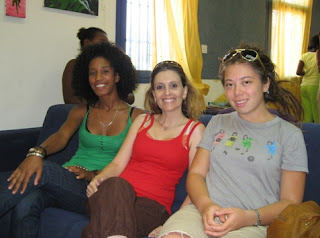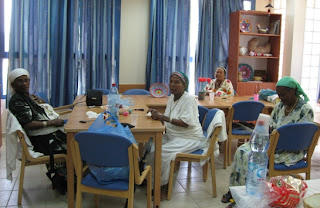This summer the TIPS Partnership started a new program, a variation of a previous one we had had a few years ago. We advertised for youth ages 17 to 20 to spend 4 weeks working as counselors at camps in Kiryat Malachi. Three youth have fit in quite well here: Sarah Yamasaki,age 20, from the Seattle area, Evan White, age 18, from Phoenix, and Korey Silverman Roati, age 17, from Tucson. Sarah had been to Israel for a year with the Reform movement after graduating from high school. Evan had been here several years ago with the Macabi games, and Korey had been to Israel with his 8th grade class and was still in touch with several youth he had met in Kiryat Malachi on that trip. Evan excels in sports, especially basketball and baseball. Korey loves volleyball and will also be the editor of his school newspaper this year.
All were placed with host families. While Sarah's did not know much English, she took advantage of the situation to improve her Hebrew. She especially enjoyed sitting with the grandma (who speaks Hebrew slowly) and looking at family wedding pictures in the Moroccan Jewish tradition and helping the mother cook and prepare for Shabbat the first weekend she was here. Korey was hosted by the Attal family. Two daughters, ages 14 and 24 approximately were at home and both known spoken English well. The parents are always busy, but Korey soon learned how to fend for himself, cooking breakfast, etc. Evan had a host sister who was his age who showed him around town the first day. All three seem to fit in well with the families.
Sarah spent 4 weeks working from 8:30 to 1 at one of the "clubs" of the social services department with kids at risk. This club, Kalanit, has 15 youth in 4th through 6th grades that participate .
 This is a photo of the outside of the "club." Like all schools, it is surrounded by a protective fence for security reasons.
This is a photo of the outside of the "club." Like all schools, it is surrounded by a protective fence for security reasons.
The swimming instructor was in the pool with the kids too, but the other "counselors" were all sitting by the side of the pool.

 Here she is with the English teacher and one of the girls. This program helps keep the girls off the streets and away from difficult home situations, teaches them positive behavior, and helps keep them in school. It was created after ten teens (most of whom were Ethiopian-Israeli) in town committed suicide a few years ago.
Here she is with the English teacher and one of the girls. This program helps keep the girls off the streets and away from difficult home situations, teaches them positive behavior, and helps keep them in school. It was created after ten teens (most of whom were Ethiopian-Israeli) in town committed suicide a few years ago. Evan helping to make fruit salad. The kids know how to chop up fruit much tinier than US youth would even consider doing!
Evan helping to make fruit salad. The kids know how to chop up fruit much tinier than US youth would even consider doing! Korey with Meir, the sports director
Korey with Meir, the sports director A youth of one group. Evan left of center and Koren to the right of #4. A "grandpa" in the straw hat was also watching.
A youth of one group. Evan left of center and Koren to the right of #4. A "grandpa" in the straw hat was also watching. This was was only the second time that Evan had played soccer. The coach told me that Evan is very athletic and was holding his own. Over 200 youth (including some girls) are involved in this program, meeting with different coaches on different nights. 15 coaches are volunteers. They are youth from town, post army, who volunteer to help the youth and inexchange for receiving leadership classes at the Wingate Sports Institute and also first aide instruction. Many of them are Ethiopian-Israeli as are many of the youth participants. This program is entirely new this year and partly supported by the TIPS partnership including the Seattle Jewish Federation. The soccer field was renovated this past year with funds from a Christian-Jewish organization. "Keren Yedidut."
This was was only the second time that Evan had played soccer. The coach told me that Evan is very athletic and was holding his own. Over 200 youth (including some girls) are involved in this program, meeting with different coaches on different nights. 15 coaches are volunteers. They are youth from town, post army, who volunteer to help the youth and inexchange for receiving leadership classes at the Wingate Sports Institute and also first aide instruction. Many of them are Ethiopian-Israeli as are many of the youth participants. This program is entirely new this year and partly supported by the TIPS partnership including the Seattle Jewish Federation. The soccer field was renovated this past year with funds from a Christian-Jewish organization. "Keren Yedidut."Although the three are not being "counselors' in the sense that they would have been in the US, they are leaving a very impressive lasting impression on this community--not just to these young children, but also with the staff with whom they are interacting. They too have the opportuntity to see in depth what it is like to live in a smaller Israeli town.

























































